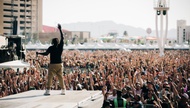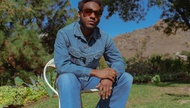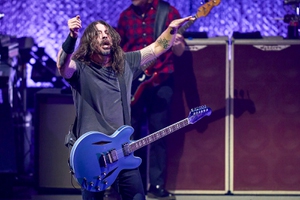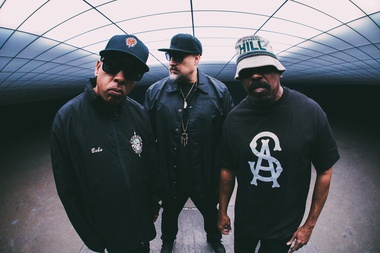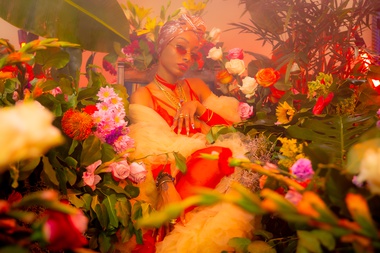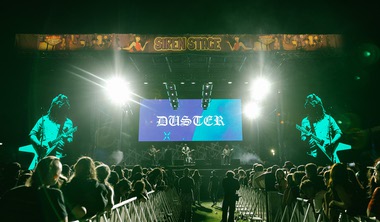It’s been 30 years since Nils Lofgren joined Bruce Springsteen’s E Street Band as the new guy. More than a decade earlier, the guitarist, then just 18 years of age, had popped up on Neil Young’s 1970 album After the Gold Rush, marking the beginning of a long association between Young and Lofgren. Additionally, the veteran singer-songwriter and multi-instrumentalist has had his own lengthy career, both solo and with the band Grin.
As Lofgren tells us during a phone conversation from his Arizona home, his recently released box set Face the Music reminds him that he hasn’t been negligent when it comes to focusing on his own music. During a break in E Street action, he’s out for some rare solo shows, tuning up with two gigs at Vinyl.
I think a lot of folks are excited that you’re coming to Vegas. It’s been awhile. Yeah, it’s a thrill to get back to the Hard Rock —my old buddy Don Marrandino is back there and we’ve been friends a long time; he’s always brought in great music, and it’s going to help me get back on my feet as a solo artist, get back to what I do. My buddy Greg Varlotta has been with me for seven or eight years, and we do a great show with a lot of electric and acoustic, keyboards, synths, a little tap dancing, trumpet and all kinds of stuff. There’s a lot of jamming.
Bruce and E Street haven’t been here for a show since 2002. That’s pretty incredible, as much as the band has been on the road. I know! I thought we were going to get back to the MGM Grand. I love playing Vegas. I was through town playing there a few years ago, and it’s always a great audience.
Your new box set probably gives you some interesting perspective as you put together a setlist. It’s a 10-disc retrospective of my 45 years of recording … [including] two discs of old stuff, you know, basement tapes, old Grin things we lost and found, a lot of demos that I love but never shared. It’s kind of a couple of albums’ worth of new songs, if you will, to look at that haven’t seen the light of day. So it will be fun to handpick some of those and get them in the setlist and just kind of tweak the others. It’s been three years since I did my own show, so I’m excited to get back to it. It will be a nice challenge.
For those who have bought the albums over the years, the archival stuff is really enticing. What was the process involved in digging that stuff up? Unfortunately, I’m not a great librarian. I had boxes of cassettes, and I used to rummage through them looking for, in one case, a cassette rough mix of Grin playing “Keith Don’t Go” with Neil Young on piano. And I couldn’t find it. But we started rummaging through all of the tapes and sure enough, we found the master to “Keith Don’t Go” from that recording session with Neil on piano and singing with Grin.
How did that version of “Keith Don’t Go” with Neil get left on the shelf at the time? That’s a good question. I’d done the Tonight’s the Night tour and written the song, and we did that rough track with Neil. But then, I think we were between record deals … I can’t even remember why that got left behind or if we decided to save it for my first solo project, which we didn’t know was going to happen two years later in ’75. But it was a mistake to leave it behind. We were all way too analytical and critical of ourselves back then.
The demo of “Awesome Girl” that’s on this set features Rick James, and it sounds like he ended up on the song very spontaneously. Did you know Rick prior to that? No. I loved his stuff, and of course he was a very mercurial character in the business. It must have been about 4 a.m., and we were at a studio in the Valley, me and Kevin McCormick, one of my producers and bass players. We got excited about this cool demo with 12-string acoustic and Kevin playing bass and programming the drum part, and I’m going in and singing the da da das and in walks Rick James, who is a friend of the owner of the home that had the studio. He was just hanging out, and all of the sudden I’m doing the harmonies and I look through the glass and I see Rick James.
When I come back in, the guy introduces us, and Rick says, “Hey, that’s a cool track; why don’t I sing with you?” And the next thing I know, we’re out there together singing the harmonies in the back and the da da das. It was really cool and fun and spontaneous, just one of those magic things that happened. And thank God we found a DAT of it, because I have no idea where the studio was or who it was. There was no chance of finding the master tape, but fortunately we had an old DAT mix, and Billy Wolf did a good job of using his analog tricks to master it up and fit it into the running order.
When you look back at your career, what’s a particular favorite moment you’re glad you were part of? I unexpectedly, at 18 years of age, did the After the Gold Rush project and learned that I could play professional piano, which I didn’t think I could, thanks to David Briggs and Neil Young. And it became more and more a part of what I did with Grin and in my solo work. I learned early on that if you’re with good people and great music, it’s nice not to be the boss every day of your life—for me. There’s a lot of solo artists that would be uncomfortable with that, but I found it very inspired and refreshing, because I love music.
I love playing rhythm guitar and singing harmony, and when you’re the main guy, you can’t do that. So that was exciting. And then, of course, it felt natural when Crazy Horse wanted me to make their first album with Danny Whitten, which I did, and that led to the Tonight’s the Night tour. But all of the chapters with Neil—Trans, MTV Unplugged—they’re all highlights, as is every show or record with the E Street Band, the two Ringo Starr All-Starr Bands, I’ve played in a couple of bands with Patti Scialfa, with Steve Jordan and Willie Weeks and other great casts of characters, and I just love being in great bands.
If it’s for me to lead the band, I’m happy doing that, I’m comfortable doing that and I’ll continue to. But as long as it’s a great ensemble of people that I like and get along with, it’s very good for my musical soul to take a break from being the boss every day and just be on a team.
Because it happened in a pre-Internet world, I had never heard the story of all of the drama that went on behind the scenes of the recording of Neil Young’s Unplugged. Yeah, that was a very hilarious chapter, looking back on it. But at the time, it was a bit maddening for me. Because if you’re going to show up at a rehearsal site and Neil Young is going to sing and play and you’re going to be in the band, you want to be prepared. Of course it’s going to evolve and of course it’s going to change, but you want to start off with the main guy being as inspired as possible, because then everything’s easier and everything is more exciting and powerful. So I showed up prepared and the other guys didn’t, and it led to a fiasco of Neil and David going off to have tequila shots while I rehearsed the band, which was very uncomfortable.
[If] these guys didn’t respect Neil enough to show up with any homework, they weren’t going to respect me. So I just said, “Look, Neil told us to rehearse, so I’m going to sing each song twice; you guys do whatever you want to do.” The next day went a little bit better, but Neil was still kind of uneasy about it. He’d already canceled the first [Unplugged] in New York, which he told me sounded awful and refused for it to come out in any fashion. So this was the second go-around where I was invited. He just wanted me to ghost his parts and double them so that if he wanted to go off and play some lead or whatever, he knew that the thing was going to be locked down. Because we played together a lot, and he knew that I had his feel down pretty good and loved his music.
One of my favorite songs that I sing in my own show is “Long May You Run,” and we started it twice. Neil stopped it twice in front of the audience; he didn’t like how it felt. He was pretty on edge, and I get it—you gave the guys weeks of notice, it’s not like you called them the night before, so you want them to show up prepared. But he said, “Let’s forget that song,” and I stopped him, in front of the audience, and said, “Man, don’t forget the song. It’s not the song’s fault,” as politely as I could, and he looked at me like, “Well, you count it off.” So I counted it off, and we got the take that’s on the record, thank God. It was just one of those great moments and I’ve had so many moments like that. It’s just called being in a band.
You’ve been a musical director of sorts at different times throughout your career, and I think that some people feel that you bring an element of that to your work with Bruce. How do you see it? I was kind of the de facto musical director in the first Ringo band, just because all of the guys respected that I showed up with the most amount of homework. [But] I’ve never been the musical director in the E Street Band; I don’t know where that rumor got started. I am the new guy in the band, even though I’ve been in the band 30 years. I’m the guy who showed up with the notebook of chord charts and the bootleg tapes, which comes in handy, but I’m certainly not the musical director of the E Street Band.
All of those guys are badass musicians that prepare in their own way, and we all help each other out. [But] the only M.D. of the E Street Band is Bruce Springsteen. I do work hard at it and practice and try to out-guess Bruce about surprises he may think of or songs that have been out of the set for awhile, as everyone else does. It’s a fun kind of adventure and mystery, because we change the show all of the time.
You’ve spoken about “Prove It All Night” and how sometimes you’ll play the guitar solo and sometimes you won’t. Either way, you’ve got to be ready with the right guitar. Yeah, I’ve gotten to the point now where I like playing rhythm, and I start on an acoustic guitar. I just realized, Bruce never knows either. He could point to Steve [Van Zandt], he could point to me, sometimes we do a duel, so I just learned in the last little break of the song to put on a Strat just in case. There’s not enough time to switch guitars. When he’s headed to a fuzz tone and changes his mind and points at you, you’ve got half a second, so you just hit your overdrive and go. It’s big fun. It gets a little bit hairy, but it is fun.
Nils Lofgren September 26 & 28, 9:30 p.m., $25-$35, all-ages. Vinyl, 702-693-5000.

